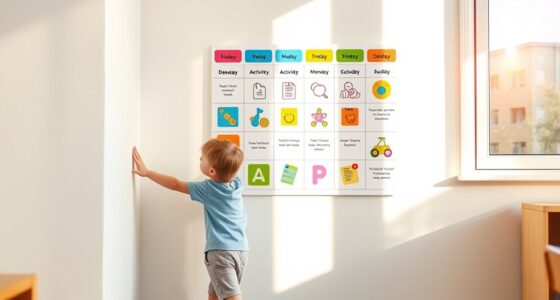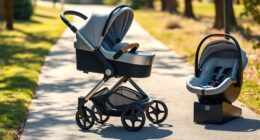To stay safe and prevent clashes, make sure all car seats are properly installed and secured, following each manufacturer’s instructions. Use narrow or adjustable seats to maximize space, and consider repositioning or temporarily removing headrests if needed. Always ensure seatbelts fit snugly across the child’s hips and shoulders. Take your time to secure each seat correctly—safety comes first. If you want to master your car seat setup, keep exploring the best techniques and tips below.
Key Takeaways
- Ensure each car seat is securely installed following manufacturer instructions to prevent movement and maintain safety.
- Properly position seatbelts across the child’s hips and shoulders for effective restraint.
- Reposition or remove headrests and adjust seats to optimize space without compromising safety.
- Use narrow or convertible seats designed for tight spaces to maximize comfort and safety.
- Prioritize safety over convenience by avoiding modifications that could weaken seat security or safety features.

If you’ve ever tried fitting multiple car seats into a single vehicle, you know how challenging it can be to avoid clashes and guarantee everyone rides safely and comfortably. Managing space becomes even trickier when you consider the variety of car seats available, especially booster seats and convertible car seats. Booster seat laws are strict for older children, typically requiring kids to use a booster until they reach a specific age or height, which can make fitting everyone in even more complicated. Booster seats are designed to elevate children so the vehicle’s seatbelt fits properly, but their size can sometimes interfere with adjacent seats or hinder proper installation. To keep everyone safe, you need to make certain each booster seat is correctly secured and that the seatbelt positioning is correct, which can be tricky when space is limited. Ensuring proper artistic design of car seats can also improve their fit and safety in tight spaces. Convertible car seats are popular because they grow with your child, transforming from rear-facing to forward-facing, and eventually into booster mode. This versatility is convenient, but their bulk can also be a source of clashes. When installing multiple convertible seats, it’s essential to follow manufacturer instructions carefully, ensuring each seat is securely anchored and not blocking other seats’ access or safety features. Many vehicles have a limited amount of space, and fitting two or more convertible car seats side by side often requires adjusting the seats or using specific installation methods, like LATCH connectors or seat belt locking clips. Sometimes, the seats’ design makes it difficult to get a tight fit, risking compromised safety or discomfort for your children.
To avoid clashes, you should always check your vehicle’s owner manual for guidance on installing multiple car seats, paying close attention to weight and height limits, and recommended seat arrangements. Some vehicles are better suited for multiple car seats than others, with wider back seats or those with lower armrests providing more room. When installing booster seats, ensure they’re properly positioned and that the seatbelt fits snugly across your child’s hips and shoulders. If space becomes tight, consider switching to narrower convertible options or repositioning seats to maximize available room. Remember, safety always comes first, so take your time to secure each seat correctly, even if it means rearranging or removing some headrests temporarily.
Frequently Asked Questions
Can I Mix Different Car Seat Brands Safely?
You can mix different car seat brands, but you need to verify brand compatibility first. Make sure both seats meet safety standards and are approved for your child’s weight and age. Always read the manufacturer’s instructions about mixing brands, as some seats may not fit well together or could compromise safety. When in doubt, consult a certified car seat technician to ensure your setup keeps your child safe on every trip.
How Do I Handle Incompatible Car Seat Fittings?
Imagine your child’s safety as a puzzle missing a vital piece. When you face installation issues or compatibility concerns with incompatible car seat fittings, stop and reassess. Check the manufacturer’s instructions and compatibility charts. If fittings don’t align, don’t force it—seek expert advice or contact customer support. Ensuring proper installation is your shield, so prioritize safety over convenience, and find the right fit for peace of mind.
Is It Okay to Rotate Seats Between Vehicles?
Yes, seat rotation is okay when vehicle switching, but you should always check that each seat fits securely in the new vehicle. Make certain the seat’s installation instructions are followed precisely, and confirm that the seat belt or LATCH system is compatible. Regularly inspect the seat’s stability after switching vehicles, and never compromise on safety for convenience. When unsure, consult your car seat manufacturer or a certified safety technician.
What Should I Do if My Car Seat Is Recalled?
Think of a recall like a safety net catching you before a fall. When your car seat is recalled, stop using it immediately. Follow the recall procedures provided by the manufacturer, which usually include contacting them for a replacement or repair. Always check for safety certification updates. Your child’s safety depends on quick action—don’t delay, and verify you get a certified, safe seat back in use.
How Can I Tell if My Child’s Seat Is Properly Installed?
You can tell if your child’s seat is properly installed by performing an installation check, ensuring the seat is securely fastened and doesn’t move more than an inch side to side or front to back. Double-check that it’s installed according to the manufacturer’s instructions and that it has current safety certification labels. If you’re unsure, visit a certified child passenger safety technician for a professional inspection to confirm your child’s seat is correctly installed and safe.
Conclusion
Staying safe in your car seat might seem tricky, but it’s all about paying attention and making smart choices. When you guarantee your child’s seat is installed correctly and fits well, you’re covering all your bases. Remember, a cautious approach keeps everyone’s worries at bay — it’s better to be safe than sorry. So, stay vigilant and keep safety top of mind; after all, it’s better to be safe than sorry when it comes to your little one’s well-being.









